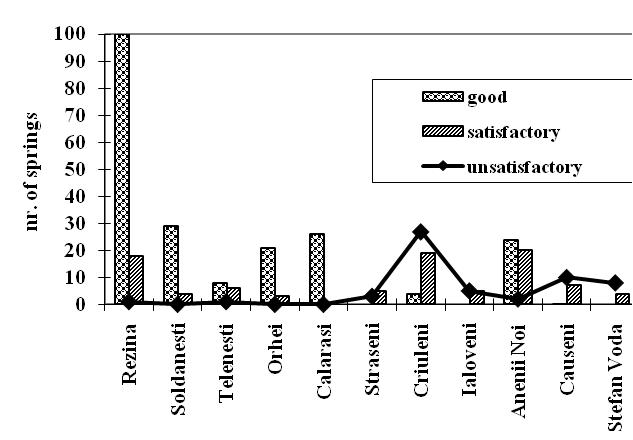Chemistry Journal of Moldova
2013 Volume 8, no.2
Author(s):
Field: Inorganic and coordination chemistry
Type: Review
Issue: 2013 Volume 8, no.2
Pages: 8-20
Andrei Rija, Eduard Coropceanu
Field: Inorganic and coordination chemistry
Type: Review
Issue: 2013 Volume 8, no.2
Pages: 8-20
Full Text (PDF): Download
DOI: dx.doi.org/10.19261/cjm.2013.08(2).01
Graphical Abstract: As a result of the comparative study of axial ligand orientation towards the equatorial plane in α - dioximates Co (III) obtained by us and those described in the specialized literature (found in Cambridge Crystallographic Data Centre) showed that the external anions and solvent molecules contribute to the orientation of axial ligands as selenourea and thiourea. For aniline and sulphanilamide ligands, is more convenient the parallel orientation to form π-π interactions between the aromatic rings of ligands and the metallocycle of equatorial plane.
Downloads: 31
Author(s):
Field: Organic chemistry
Type: Review
Issue: 2013 Volume 8, no.2
Pages: 21-31
Veaceslav Boldescu, Valeriu Crudu, Natalia Sucman, Serghei Pogrebnoi, Marina Zviaghinţeva, Eugenia Stîngaci, Vsevolod Pogrebnoi, Fliur Macaev
Field: Organic chemistry
Type: Review
Issue: 2013 Volume 8, no.2
Pages: 21-31
Full Text (PDF): Download
DOI: dx.doi.org/10.19261/cjm.2013.08(2).02
Graphical Abstract: Macrophages play an important role in the pathological development of different diseases. Therefore, macrophage targeting represents an important challenge in design of new medicines. This review gives a general presentation of small molecule-recognition concepts used for macrophage targeting. It describes mechanisms and systems for macrophage-targeted delivery, their obtaining and application.
Downloads: 111
Author(s):
Field: Physical chemistry and chemical physics
Type: Review
Issue: 2013 Volume 8, no.2
Pages: 32-41
Lilia Anghel, Gheorghe Duca
Field: Physical chemistry and chemical physics
Type: Review
Issue: 2013 Volume 8, no.2
Pages: 32-41
Full Text (PDF): Download
DOI: dx.doi.org/10.19261/cjm.2013.08(2).03
Graphical Abstract: Iron-based nanoparticles have gained a lot of attention due to their properties which offer a broad range of biomedical and industrial applications. Traditional methods of synthesis of iron nanoparticles strongly influence their properties and limit their applicability. Recently, there has been a growing interest in the development of biological routes of syntheses of iron nanoparticles as the resulting particles have structural characteristics required by biomedical field. The mechanism for the synthesis of iron-based nanoparticles by microorganisms and its current limitation are presented.
Downloads: 53
Author(s):
Field: Ecological chemistry
Type: Research paper
Issue: 2013 Volume 8, no.2
Pages: 42-50
Maria Sandu, Anatol Tarita, Raisa Lozan, Viorica Gladchi, Gheorghe Duca, Sergiu Turcan, Elena Mosanu, Afanasie Prepelita
Field: Ecological chemistry
Type: Research paper
Issue: 2013 Volume 8, no.2
Pages: 42-50
Full Text (PDF): Download
Abstract (PDF)
DOI: dx.doi.org/10.19261/cjm.2013.08(2).04
Graphical Abstract:
In Memory of Valeriu Ropot for his scientific contributions in Waters Protection
The present study estimates chemical composition and status of the groundwater from the Dniester river basin. Research includes defining of springs/fountains location, evaluating physicochemical features of water, highlighting of main pollutants and pollution sources, establishing of water type and quality. The research was achieved within the State Program "Scientific research and water quality management".

Downloads: 55
DOI: dx.doi.org/10.19261/cjm.2013.08(2).04
Graphical Abstract:
In Memory of Valeriu Ropot for his scientific contributions in Waters Protection
The present study estimates chemical composition and status of the groundwater from the Dniester river basin. Research includes defining of springs/fountains location, evaluating physicochemical features of water, highlighting of main pollutants and pollution sources, establishing of water type and quality. The research was achieved within the State Program "Scientific research and water quality management".
Downloads: 55
Author(s):
Field: Ecological chemistry
Type: Research paper
Issue: 2013 Volume 8, no.2
Pages: 51-56
Larisa Postolachi
Field: Ecological chemistry
Type: Research paper
Issue: 2013 Volume 8, no.2
Pages: 51-56
Full Text (PDF): Download
DOI: dx.doi.org/10.19261/cjm.2013.08(2).05
Graphical Abstract: The results suggest that during the re-suspension, bottom sediments can become a relevant source of heavy metals and phosphorus forms which are mobilized in the water horizon overlying the bottom sediments.
Downloads: 28
Author(s):
Field: Ecological chemistry
Type: Research paper
Issue: 2013 Volume 8, no.2
Pages: 57-66
Larisa Postolachi, Vasile Rusu, Tudor Lupascu
Field: Ecological chemistry
Type: Research paper
Issue: 2013 Volume 8, no.2
Pages: 57-66
Full Text (PDF): Download
DOI: dx.doi.org/10.19261/cjm.2013.08(2).06
Graphical Abstract: The supplemented scheme for determination of phosphorus forms in natural waters was tested for the River Prut.
Downloads: 24
Author(s):
Field: Ecological chemistry
Type: Research paper
Issue: 2013 Volume 8, no.2
Pages: 67-72
Povar Igor, Spinu Oxana
Field: Ecological chemistry
Type: Research paper
Issue: 2013 Volume 8, no.2
Pages: 67-72
Full Text (PDF): Download
DOI: dx.doi.org/10.19261/cjm.2013.08(2).07
Graphical Abstract: The key quantitative characteristics of the theory of buffer action for polycomponent mono- and two-phase systems have been derived. It is shown, that the buffer properties in relation to the solid phase components are amplified with an increase of solubility due to protolytic or complex formation equilibria in saturated solutions.
Downloads: 27
Author(s):
Field: Food chemistry
Type: Research paper
Issue: 2013 Volume 8, no.2
Pages: 73-77
Ecaterina Covaci, Gheorghe Duca, Rodica Sturza
Field: Food chemistry
Type: Research paper
Issue: 2013 Volume 8, no.2
Pages: 73-77
Full Text (PDF): Download
DOI: dx.doi.org/10.19261/cjm.2013.08(2).08
Graphical Abstract: Crystalline precipitate which occurs due to the presence of tartaric salts is frequently encountered in young wines in form of white-dirty lamellar crystals at the bottom of tank. The aim of the study is to prevent the tartaric salts from crystallization in young wine blend Biance/Sauvignon by implementing various schemes and procedures.
Downloads: 22
Author(s):
Field: Inorganic and coordination chemistry
Type: Research paper
Issue: 2013 Volume 8, no.2
Pages: 78-82
Carolina Vomisescu, Paulina Bourosh, Victor Kravtsov, Diana Dragancea
Field: Inorganic and coordination chemistry
Type: Research paper
Issue: 2013 Volume 8, no.2
Pages: 78-82
Full Text (PDF): Download
DOI: dx.doi.org/10.19261/cjm.2013.08(2).09
Graphical Abstract: An ONO tridentate semicarbazone Schiff base and a bidentate dipyridyl ligand give a nickel(II) dimer, where atom centers are bridged by phenolate oxygen donors.
Downloads: 57
Author(s):
Field: Inorganic and coordination chemistry
Type: Research paper
Issue: 2013 Volume 8, no.2
Pages: 83-89
Viorina Gorinchoy, Sergiu Shova, Elena Melnic, Victor Kravtsov, ConstantinTurta
Field: Inorganic and coordination chemistry
Type: Research paper
Issue: 2013 Volume 8, no.2
Pages: 83-89
Full Text (PDF): Download
DOI: dx.doi.org/10.19261/cjm.2013.08(2).10
Graphical Abstract: A reaction of iron and barium nitrate with ammonium salicylate in the mixture of solvents leads to the formation of the new homotrinuclear complex, [Fe3O(SalH)7(H2O)2]∙(DMAA)2(MeOH)(THF)1,5(H2O)2,6. Single-crystal X-ray study shows that the titled complex with the moiety {Fe3O} belongs to the well-known group of μ3-oxohomotrinuclear carboxylates. The IR and MS studies are in accordance with x-ray data. Thermal behaviour of the complex was studied.
Downloads: 68






